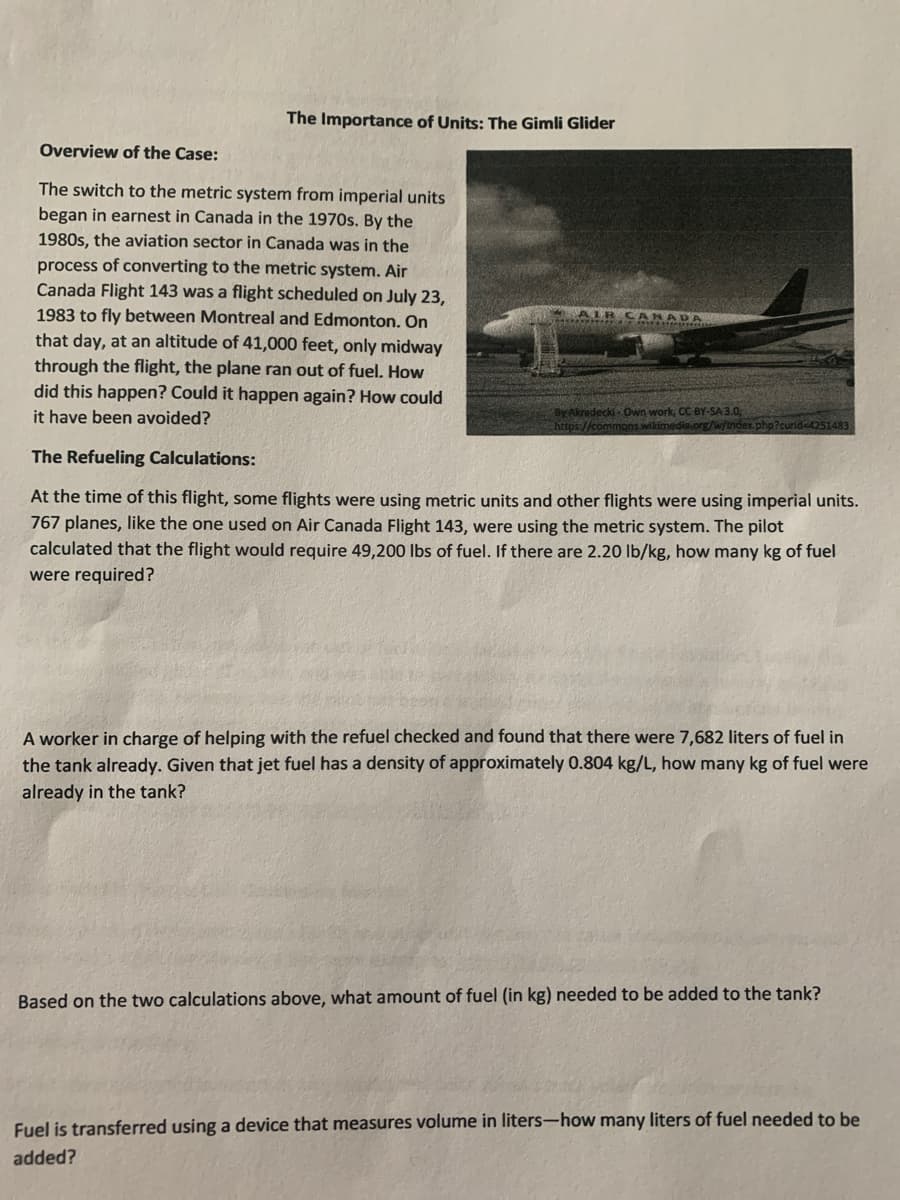Chemistry: Principles and Reactions
8th Edition
ISBN:9781305079373
Author:William L. Masterton, Cecile N. Hurley
Publisher:William L. Masterton, Cecile N. Hurley
Chapter1: Matter And Measurements
Section: Chapter Questions
Problem 38QAP: A gasoline station in Manila, Philippines, charges 38.46 pesos per liter of unleaded gasoline at a...
Related questions
Question
At the time of this flight, some flights were using metric units and other flights were using imperial units. 767 planes, like the one used on Air Canada Flight 143, were using the metric system. The pilot calculated that the flight would require 49,000 lbs of fuel. If there are 2.20 lb/kg, how many kg of fuel were required

Transcribed Image Text:The Importance of Units: The Gimli Glider
Overview of the Case:
The switch to the metric system from imperial units
began in earnest in Canada in the 1970s. By the
1980s, the aviation sector in Canada was in the
process of converting to the metric system. Air
Canada Flight 143 was a flight scheduled on July 23,
1983 to fly between Montreal and Edmonton. On
AIR CANADA
that day, at an altitude of 41,000 feet, only midway
through the flight, the plane ran out of fuel. How
did this happen? Could it happen again? How could
ByAkradecki - Own work, CC BY-SA 3.0,
https://commans.wikimedia.org//w/tndex.php?curid-4251483
it have been avoided?
The Refueling Calculations:
At the time of this flight, some flights were using metric units and other flights were using imperial units.
767 planes, like the one used on Air Canada Flight 143, were using the metric system. The pilot
calculated that the flight would require 49,200 lbs of fuel. If there are 2.20 lb/kg, how many kg of fuel
were required?
A worker in charge of helping with the refuel checked and found that there were 7,682 liters of fuel in
the tank already. Given that jet fuel has a density of approximately 0.804 kg/L, how many kg of fuel were
already in the tank?
Based on the two calculations above, what amount of fuel (in kg) needed to be added to the tank?
Fuel is transferred using a device that measures volume in liters-how many liters of fuel needed to be
added?
Expert Solution
This question has been solved!
Explore an expertly crafted, step-by-step solution for a thorough understanding of key concepts.
This is a popular solution!
Trending now
This is a popular solution!
Step by step
Solved in 2 steps with 2 images

Knowledge Booster
Learn more about
Need a deep-dive on the concept behind this application? Look no further. Learn more about this topic, chemistry and related others by exploring similar questions and additional content below.Recommended textbooks for you

Chemistry: Principles and Reactions
Chemistry
ISBN:
9781305079373
Author:
William L. Masterton, Cecile N. Hurley
Publisher:
Cengage Learning

Introductory Chemistry: A Foundation
Chemistry
ISBN:
9781337399425
Author:
Steven S. Zumdahl, Donald J. DeCoste
Publisher:
Cengage Learning

General Chemistry - Standalone book (MindTap Cour…
Chemistry
ISBN:
9781305580343
Author:
Steven D. Gammon, Ebbing, Darrell Ebbing, Steven D., Darrell; Gammon, Darrell Ebbing; Steven D. Gammon, Darrell D.; Gammon, Ebbing; Steven D. Gammon; Darrell
Publisher:
Cengage Learning

Chemistry: Principles and Reactions
Chemistry
ISBN:
9781305079373
Author:
William L. Masterton, Cecile N. Hurley
Publisher:
Cengage Learning

Introductory Chemistry: A Foundation
Chemistry
ISBN:
9781337399425
Author:
Steven S. Zumdahl, Donald J. DeCoste
Publisher:
Cengage Learning

General Chemistry - Standalone book (MindTap Cour…
Chemistry
ISBN:
9781305580343
Author:
Steven D. Gammon, Ebbing, Darrell Ebbing, Steven D., Darrell; Gammon, Darrell Ebbing; Steven D. Gammon, Darrell D.; Gammon, Ebbing; Steven D. Gammon; Darrell
Publisher:
Cengage Learning

World of Chemistry, 3rd edition
Chemistry
ISBN:
9781133109655
Author:
Steven S. Zumdahl, Susan L. Zumdahl, Donald J. DeCoste
Publisher:
Brooks / Cole / Cengage Learning

